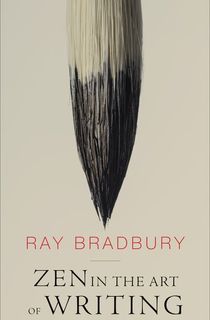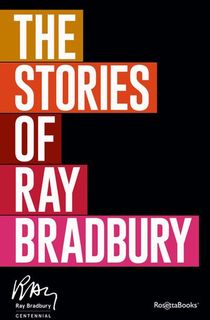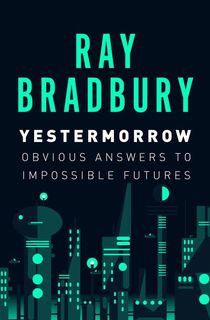One of the best-known writers of the 20th century—in any genre—The New York Times called Ray Bradbury “the writer most responsible for bringing modern science fiction into the literary mainstream.” But while Bradbury’s most popular works were science fiction, he was never constrained by genres, by forms, or by modes.
Besides sci-fi classics like Fahrenheit 451 and The Martian Chronicles, Bradbury wrote mysteries, horror stories, coming-of-age tales, fictionalized memoirs, and sometimes works that combined all of the above.
With a distinct voice and an unmistakable love of language, Bradbury’s singular stories explore dystopian futures, idyllic pasts, and worlds that never were and never will be.
For both old fans and newcomers, these must-read Ray Bradbury books show the range and the depth of the master’s many tales, and will give you a solid entry point into his oeuvre, no matter what aspect of it you’re interested in. We've included all 11 of Bradbury's published novels, as well as a few collections of short stories, so you have plenty of options to choose from.
Ray Bradbury's Novels (in Order of Publication)

The Martian Chronicles
Bradbury's first novel, The Martian Chronicles, is actually a collection of previously-published stories, brought together in one volume with a linking interstitial narrative.
The narrative follows American settlers who head to Mars following nuclear devastation on Earth. However, the red planet is already occupied by the Martians themselves. Many of the stories are anti-colonialist and explore the downsides of the American dream.
Bradbury said of The Martian Chronicles, "I read Winesburg, Ohio by Sherwood Anderson when I was 24 and I said to myself, 'Oh God, wouldn't it be wonderful if someday I could write a book as good as this but put it on the planet Mars.'"
Bradbury's Martian story cycle has since been adapted into an opera, a video game, numerous TV serials, and more.

Fahrenheit 451
Without a doubt the best-known of Bradbury’s works, most people read Fahrenheit 451—a cautionary tale about a dystopian future in which books have been banned—sometime in school.
The short novel, originally published in 1953, was one of Bradbury’s earliest successes, and it shows the author at his sharpest and his most biting.
There is warmth and heart in Fahrenheit 451, as there is in almost all of Bradbury’s works. But there is also coldness and despair alongside hope and a possible way forward in even the darkest of circumstances.

Dandelion Wine
Expanded from a short story of the same name, 1957's Dandelion Wine is set in Green Town, a fictional location in Illinois thought to represent Bradbury's boyhood hometown.
A coming-of-age story set over the course of a summer, Dandelion Wine is just as bittersweet and intoxicating as its namesake beverage.

Something Wicked This Way Comes
If Bradbury’s best-known novel is a grim look at an all-too-possible future, one of his most beloved works is a coming-of-age story set in a seemingly idyllic past.
In Something Wicked This Way Comes, the carnival comes to a small Illinois town, blown in on an autumn wind and bringing with it a darkness that will change the lives of two boys forever.
The book, originally published in 1962, changed the world of fantasy and horror literature. Not only does it set up the template for all “dark carnival” stories to come, but it also established one of the great coming-of-age fantasies in American literature.

The Halloween Tree
As much as Bradbury loved rocket ships and other planets, dinosaurs and dark carnivals, he also loved Halloween. Nowhere is that love more apparent than in this book, which can be described as little besides a love letter to the holiday.
The Halloween Tree was originally written as a part of a collaboration with animator Chuck Jones in 1972, and eventually the project came full circle when Bradbury wrote and narrated an animated adaptation in 1993, which won him an Emmy.

Death Is a Lonely Business
Throughout his long career, Bradbury dabbled in just about every type of writing imaginable, from poetry to memoirs, screenplays to mystery novels.
The 1985 mystery Death Is a Lonely Business draws elements of its narrative from Bradbury’s own early life, when he was a struggling young writer in Venice Beach before the success of his earliest books. Set in 1949, the book follows an unnamed writer and Bradbury stand-in who, along with a detective, investigates a series of murders that are haunting the declining seaside community.

A Graveyard for Lunatics
Set five years after Death Is a Lonely Business, the second entry in Bradbury's trilogy of Hollywood-centric mysteries takes place on Halloween night. It follows a new screenwriter and an investigation revolving around the Maximus Films backlot and the graveyard that is separated from the studio by a single wall. Inspired by Bradbury's own experiences as a screenwriter, several of the characters in the work are based on the friendships he made with fellow filmmakers.

Green Shadows, White Whale
In 1953, Bradbury went to Ireland to write the John Huston-directed adaptation of Moby Dick. Released in 1956 and starring Gregory Peck, this movie is considered the definitive adaptation of Herman Melville's work.
In 1992, Bradbury published Green Shadows, White Whale, a fictionalized account of his experience working with Huston on the script. Kirkus Reviews hailed the novel as “Bradbury’s triumph. He has never written better.”
Bradbury also fictionalized his experiences working on the movie in the short story “Banshee,” which was adapted for television on an episode of The Ray Bradbury Theater.
In this episode, the Huston-analogue was played by Peter O’Toole, while the Bradbury character was played by Charles Martin Smith.

From the Dust Returned
From the Dust Returned, published in 2001, is a fix-up fantasy novel, which means that it was originally a series of published or unpublished short stories that were eventually made into one cohesive story. In this case, six of the stories had been previously published, while three new short stories were included with other chapters that acted as connective tissue. So what is the actual story?
The plot follows a group of remarkable people in a house of legend similar arc to Mervyn Peake's Titus Groan or, more recently, Disney's Encanto. The best comparison, however, is the Addams family. In fact, Charles Addaps provided the cover illustration for the first story of Bradbury's Elliott family ("Homecoming"), which was published in 1946.
The Elliotts have lived since before the Sphinx was built and have spread across the globe. A gala becomes the motive for a strange and exhilarating homecoming.

Let's All Kill Constance
The penultimate novel of Bradbury's career also concluded Bradbury's mystery series. Published in 2002, the novel reconnects readers with the unnamed narrator. This time, the plot follows aging Hollywood actress Constance Rattigan, who gives our narrator two unnerving books. One lists the Tinseltown dead, and the other focuses on those soon to join them. Constance's name is in the book of soon-to-be dead, and it's up to the narrator (with the help of private investigator Elmo Crumley) to unravel the mystery before the prediction comes true.
The only problem? He's not entirely sure that Constance herself isn't the killer …

Farewell Summer
If you think you've been waiting a long time for The Winds of Winter or The Doors of Stone, just remember Bradbury's Greentown books. While Dandelion Wine was published in 1957, it wasn't until 2006 that it finally received a sequel. The last book of Bradbury's career simultaneously revisits the author's childhood while examining the stress of aging. It follows 14-year-old Doug Spaulding and Colonel Quartermain, the crusty old guardian of the school board. Doug wants to soak up the last warm days of summer, while Quartermain needs a reminder of what it's like to be young and free.
4 More Ray Bradbury Books

Zen in the Art of Writing
“Bradbury lovers will find this a Bradbury feast,” says Kirkus Reviews of this nonfiction book. In it, Bradbury lays out not so much how to write as why.
In Zen in the Art of Writing, Bradbury explains how worldbuilding and storytelling led to his prolific career as one of the world’s most beloved fantasists.
There are, indeed, few better places to learn about writing than from someone who has won just about every award and accolade available to the craft, including the National Medal of the Arts.
Heck, Bradbury even has an award named after him—the Ray Bradbury Award for Outstanding Dramatic Presentation, which is given out every year as part of the Nebula Awards.

The Stories of Ray Bradbury
Though best known for works like Fahrenheit 451, Bradbury was most prolific as a short story writer. He wrote hundreds of tales across all manner of genres, published in some of the nation’s leading periodicals and collected into dozens of acclaimed volumes.
The Stories of Ray Bradbury is a career-spanning “best of” that collects many of the author’s beloved tales, gathered from a dozen of his most famous books and packaged together for the first time.
Spanning three decades, there is no better way to experience the width and breadth of Bradbury’s short stories than in this exhaustive tome of wonders, horrors, delights, and warnings.

The Illustrated Man
Like The Martian Chronicles, 1951's The Illustrated Man is a series of short stories bridged by a frame narrative. The connective tissue of the story is the titular man, whose body art represents the classic tales in this book, including "The Veldt," "The Rocket," "The Fox and the Forest," and other greats.

Yestermorrow
Bradbury may be best remembered for his seemingly-inexhaustible imagination, as captured in his copious works of fiction. But his glimpses into the future (and the present) didn’t end with the fictional, and he also turned his pen to memoirs and musings on the state of the real world, and the direction we were headed.
Many of these are gathered in this extraordinary collection of essays, poetry, and philosophical reflection that tackles not only the future of humanity, but the history of how some of Bradbury’s most well-loved tales came to be.
This post is sponsored by Open Road Media. Thank you for supporting our partners, who make it possible for The Portalist to celebrate the sci-fi and fantasy stories you love.












